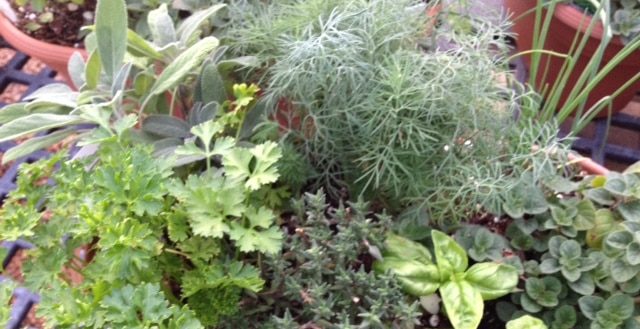There are many benefits to growing herbs in containers. Having access to fresh herbs near the kitchen is the obvious benefit. In addition, different herbs have different moisture needs and growing them in pots is an easy way to control soil moisture. Successful herb growing in containers is easiest outdoors, but can be successful indoors with bright light conditions as well.
Basil
Basil is the go-to herb in summer. Grow varieties like Genovese, the large leaf sweet basil. Basil is a warm weather annual herb and thrives when grown in pots and window-boxes in a sunny location. Growing in a well-drained potting mix like ProMix Potting Soil and bright sunshine are the keys to success. Like most herbs, basil responds well to frequent harvesting, and will continue to push out fresh growth when trimmed back. Pinch off any flower buds that appear. Once basil begins to flower, the leaf flavor declines.
Italian Oregano
Oregano is a vigorous grower in the garden and planting it in a pot is an easy way to control its growth. The small leaves are packed with flavor, perfect for seasoning Italian dishes.
Rosemary
Rosemary is a woody shrub with aromatic, needle-like foliage that is an annual in Colorado, but growing it in pots makes it easy to bring indoors to a sunny windowsill once the days start to cool down in mid-autumn. The quickest way to kill container-grown rosemary is by watering it too much; it needs consistent moisture, not wet feet.
Thyme
Thyme is one of the best herbs for container gardening; it’s low maintenance, drought-tolerant, and can take a bit of neglect. Plus, it looks fantastic when planted at the front of a container where the tiny leaves can mound over the edge of the pot. Give it full sun and don’t overwater; it’s drought-resistant and prefers its soil on the dry side.
Dill
A dwarf variety of like like Fernleaf Dill is a great selection to be grown in a container. The ferny leaves offer texture and the height of the plant offers substance in the container. Bright light and an opportunity for the soil to dry out a little between waterings is important. Use fresh for seasoning fish on the grill.
Parsley
Parsley may be a close second to Basil in popularity. Grow the two main types; curly or flat leaf parsley, in both garden beds and containers. Parsley is very easy to grow, but like mint, does want regular moisture and feeding. Parsley also appreciates full sun but will take some light shading.
Chives
An onion cousin, chives are a little slower to grow but offer offer great flavoring. Plus they will continue to grow after harvest. And their spiky growing habit offers a taller dimension and texture in a container.
Growing Tips for Herbs in Containers
1) Pick containers with drainage holes. Whether you’re growing vegetables, flowers, or herbs in pots, you’ll find the greatest success when you use containers with adequate drainage. Most pots come with drainage holes, but they can easily be added to wooden or plastic pots.
2) Fill pots with a good quality potting soil. It may be tempting to fill your containers with garden soil, but garden soil quickly compacts in pots, reducing soil drainage and porosity.
3) Harvest regularly. Frequent harvesting with pruners or snips encourages fresh growth, so don’t be shy about pinching and clipping your homegrown herbs.
4) Water consistently. Certain herbs prefer very well-drained soil (thyme, oregano, rosemary), while others like more moisture (mint, coriander, lemon balm)
5) Feed occasionally. To promote healthy growth, feed your herbs with a general purpose fertilizer like Jacks All Purpose.

